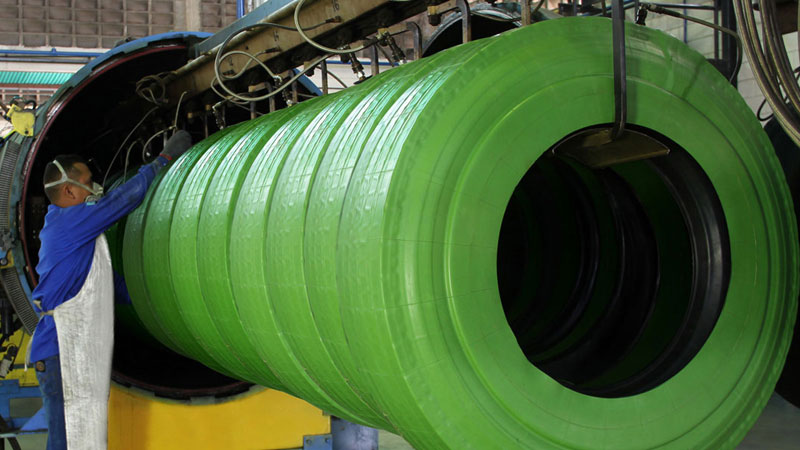Retreading

The retreading process consists in applying a new tread on the original casing, which has been previously restored to its optimal conditions, by following the same procedures as for the production of a new tyre.
How does retread work
Retreading is a long process that requires a number of steps that shall be performed with the maximum level of attention and precision. It generally involves and foresees the replacement of the rubber components of the tyre only, while the tyre structure remains unimpaired.
The first step consists in carrying out an initial inspection. During this step, the tyre is placed on a specific machinery which allows to verify any damage present on the casing. Injuries must be marked to ease and speed up, on the one hand, the following repairing steps, and, on the other hand, the discarding of the tyres that don’t fulfil the safety conditions. The initial inspection is fundamental to the success of the entire retreading process.
Then, using non-destructive equipment, inspectors check the inner part of the casing to verify if there are cuts, broken steel cords or any other damage in the casing. Those tires that do not pass this test, won’t be retreaded; they will be discarded instead.
The following step is buffing, during which the remaining rubber of the tread is completely removed from the casing. This process is performed by a specific buffing machine which provides the right shape, size and texture that guarantee the best tread-to-road contact.
The fourth step is repairing and cleaning craters, during which possible damages and imperfections of the casing are detected, then repaired and cleaned, provided that damages are within acceptable limits and repairable. A tire that was reapaired following the safety standards, is intended to last the life of the new tread being applied. At this point, the tread’s surface is ready for the application of the new tread. The casing is covered with a chemical solution which ensures that the new tread is fixed on the casing until the vulcanization. The tread can be now applied to the casing.
Once the new tread is applied, the casing undergoes a process of vulcanization, or curing, that is performed with specified heat and pressure. There are two methods: hot vulcanization process (between 150° and 160°) and (around 105°). This process, under appropriate conditions of temperature and pressure, allows to vulcanize the tread to the casing under same conditions as for new tyres.
The retreading process can be considered completed only after the final inspection. During this step, all retreaded tires are closely inspected to ensure that the product is in perfect safety conditions and that it guarantees the highest performance.
Why choose retreaded tires?
Safety
Retreading process is an activity that is carried out in accordance with the global safety standards with high technological machines and qualified workers. Moreover, since 2004 is to make mandatory the provisions on the approval of the production of retreaded tyres intended for passenger cars and commercial vehicles included respectively in UN/ECE Regulations n° 108 and 109. These regulations certificate that retreaded tyres are tested according to the same criteria as new tyres. In this way, retreads can drive offering the same performances and safety as new tyres.
Economy
Retreaded tyres offer the same qualities and performances as new ones, but with remarkable benefits in monetary terms. We are talking about 30% - 50% savings as compared to a new tyre, with the same benefits. The reasons that cause premature damages of a tire, are: pressure (too low or too high), tires’ overload, and high speed, whether the tires are new or retreaded. That’s why a correct maintenance is fundamental.
A retreaded tire is highly convenient just because it does not include the manufacturing cost of the casing of the tire, that is what affects its price the most. The tread of a tire is just a tiny part of its final price.
Account must be taken of the fact that all truck tyres producers, without exception, produce their tyres with the purpose of retreading them; therefore, tyres are actually designed to be retreaded.
Eco-sustainability
Retreading is an highly eco-sustainable activity and it should be considered among the best practices of used tyres’ recycling. Unlike other tyres’ recycling practices, retreading does not confine itself to extend their life, but it actively contributes to reduce the number of tyres that are produced every year also, which allows to save an high number of natural resources, such as oil and steel, also limiting emissions of harmful substances and CO2 (greenhouse gases). Retreading a normal tyre, that is a tire for a passenger car, helps save 5 gallons of oil; for a commercial vehicle we are saving 15 gallons of oil. To be more specific, the manufacture of a new medium truck tire requires approximately 22 gallons, while it takes only 7 gallons to retread.
A tyre can be retreaded several times, and once it can’t be retreaded anymore, the raw material that has been used to produce (or to retread) it may be used for other recycling practices.